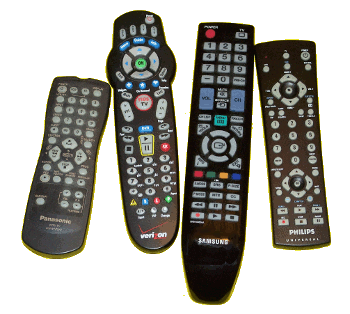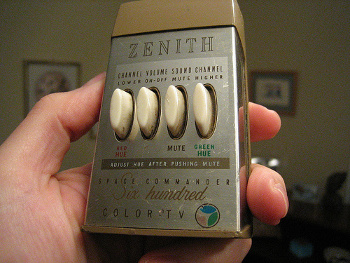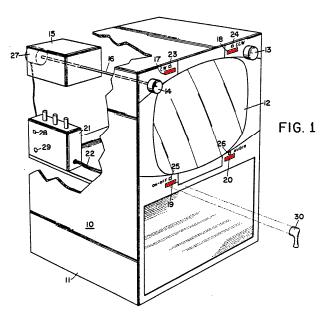Eugene Polley and the Television Remote
May 25, 2012
Nikola Tesla patented the first
remote control device in 1898. He used
radio and a
coherer detector to control a boat just a decade after
Heinrich Hertz demonstrated the existence of radio waves. Tesla's 1898 patent was referenced by another patent as late as 2005.[1]

A collection of infrared remote control devices in my house. The Verizon FIOS remote gets the most use.
(Photo by author)
The remote control devices that are most used, today, don't use radio waves.
Television remote controls (see photograph, above) use
infrared light, a technology that was practical to implement only after the development of the
light-emitting diode. Television, however, has been with us since the late 1940s, and it's understandable that some form of remote control was wanted shortly thereafter.
The simplest, but not very
aesthetic, nor safe, solution was to have a wire connect a television with remote buttons.
Eugene Polley, who worked for
Zenith Electronics, a major television manufacturer, created the first true television remote in 1955.[2] Polley's device used light, but not
digitally encoded light as is used in today's remotes. Polley's data was
spatially encoded; that is, you needed to point a light at certain portions of the television set for control. Polley died on May 20, 2012, at age 96.[3-9]
In a story that was common in the past, but not much today, Polley, who was not a
college graduate, began work at Zenith as a stock boy, and he worked his way into the
engineering department. During
World War II, he worked on ship-detecting
radar and
fuses for bombs.[6]
A patent application for his remote control device, called the Flash-Matic, was filed in 1955, but he continued inventing after that time, spending forty-seven years with Zenith and earning eighteen US patents. Polley received a $1,000
bonus for the Flash-Matic.[6] The invention, which was only marketed for one year, grossed about three million dollars for Zenith.
One of Polley's other inventions, which I wrote about in a
previous article (Couch Potato Hero, February 22, 2007), was an
ultrasonic version of his optical remote. He developed this with
physicist,
Robert Adler, who died in 2007 at age ninety-three.[10] The ultrasonic idea was Polley's, and Adler's design was novel in that it didn't need
batteries. Mechanical motion would ring
metal tines that
vibrated at ultrasonic frequencies. The ultrasonic remote was named the "Space Command."[3]

This later version of the ultrasonic remote, the Zenith Space Commander 600, was sold with color television sets between 1965 and 1972.
(Via Wikimedia Commons))
The metal tines were of different length, so they vibrated at different
frequencies. These frequencies were detected at the television, although there was sometimes interference from other sound sources, such as jangling
keys and spilled
coins. Zenith sold more than nine million of the ultrasonic remotes between 1956 and 1982.
Polley's "Flash-Matic" remote worked by flashing a light beam from a handheld unit onto one of four
photodetectors in the television (see diagram). One photodetector turned the set on and off, two others changed the
channel up or down, and a third muted the sound.[6] The mute feature appealed to Zenith's founder and president, Eugene F McDonald, who thought that
commercials were too distracting. One
advertisement for the Flash-Matic states, "You can even shut off annoying commercials while the picture remains on the screen. Just a flash of light does it."[7]
The device worked, but televisions would sometimes be triggered by
sunlight and
room lights. The remote feature added about 20% to the cost of a television set.[9] Nonetheless, Zenith sold nearly 30,000 "Flash-Matic" equipped televisions. Another problem was that Polley's unit needed a battery, and these were much larger and didn't last as long as the batteries in today's remotes. The ultrasonic remote solved the battery problem.

Figure one of US Patent No. 2,903,575, "Control System," by E. J. Polley,
September 8, 1959.
I've highlighted the photocell locations in red.
(Via Google Patents))
Since Polley had developed the "Flash-Matic," and both Polley and Adler were involved with the ultrasonic remote, they are credited as co-inventors of remote technology. Adler and Polley were awarded an
Emmy in 1997 by the
National Academy of Television Arts and Sciences.
In a
controversy reminiscent of the
invention of another optical device, the
laser, it appeared that Adler took most of the credit for the invention of the television remote. It was Adler, not Polley, who appeared on "
The Tonight Show with Jay Leno."[3] Polley's son is quoted in the
Los Angeles Times as saying, "My father's point of view was that when somebody came up with the jet engine for the airplane, he didn't take credit away from the Wright Brothers... But Bob Adler tried to steal his thunder as the inventor of the remote control."[3]
Polley is quoted in
The New York Times as saying, in a 2002 interview, "A father has to be present at conception... And if you're not, you're not the father."[6] Zenith considered Polley and Adler to be co-inventors of the television remote.[3] Adler, late in his life, admitted that Polley didn't receive enough of the credit. Adler thought that the remote was one of his least-important inventions.[3]
Polley disagreed, comparing the invention of the remote to the invention of the
flush toilet, and saying it was almost as important as
sex.[6,9] He would proudly show the original remote to visitor to his home.[5]
References:
- Nikola Tesla, "Method and Apparatus for Controlling Mechanism of Moving Vessels or Vehicles," US Patent No. 613,809, November 8, 1898.
- E. J. Polley, "Control System," US Patent No. 2,903,575, September 8, 1959.
- Brian Slodysko, "Eugene Polley dies at 96; inventor of wireless TV remote control," Los Angeles Times, May 23, 2012.
- Eugene Polley, inventor of TV remote control, dies at 96, Guardian (UK), May 23, 2012.
- Hannah Furness, "Eugene Polley, inventor of the remote control, dies aged 96," Telegraph (UK), May 23, 2012.
- Margalit Fox, "Eugene Polley, Conjuror of a Device That Changed TV Habits, Dies at 96," The New York Times, May 22, 2012.
- Hannah Rand, "The couch potato's hero: Inventor of the world's first remote television control dies," Daily Mail (UK), May 22, 2012.
- TV remote control inventor Eugene Polley dies at 96, BBC News, May 22, 2012.
- Emily Langer, "Eugene J. Polley, engineer who invented the first wireless TV remote control, dies at 96," Washington Post, May 22, 2012.
- Patricia Sullivan, "Robert Adler, 93; Engineer, Co-Inventor of TV Remote Control." (Washington Post)
- 1959 Zenith Space Command Television, YouTube video, May 29, 2009.
Permanent Link to this article
Linked Keywords: Nikola Tesla; patent; radio control; remote control device; radio; coherer detector; Heinrich Hertz; Verizon FIOS; television remote control; infrared lightvlight-emitting diode; television; aesthetics; aesthetic; Eugene Polley; Zenith Electronics; digital; digitally encoded; spatial; college graduate; engineering; World War II; radar; bomb fuse; bonus; ultrasound; ultrasonic; physicist; Robert Adler; battery; metal; tine; vibration; Wikimedia Commons; frequency; key; coin; photodetector; channel; television advertisement; commercial; advertisement; sunlight; room light; Google Patents; Emmy Award; National Academy of Television Arts and Sciences; controversy; Gordon Gould; Invention of the laser; laser; The Tonight Show with Jay Leno; Los Angeles Times; The New York Times; flush toilet; sex; US Patent No. 613,809; US Patent No. 2,903,575.